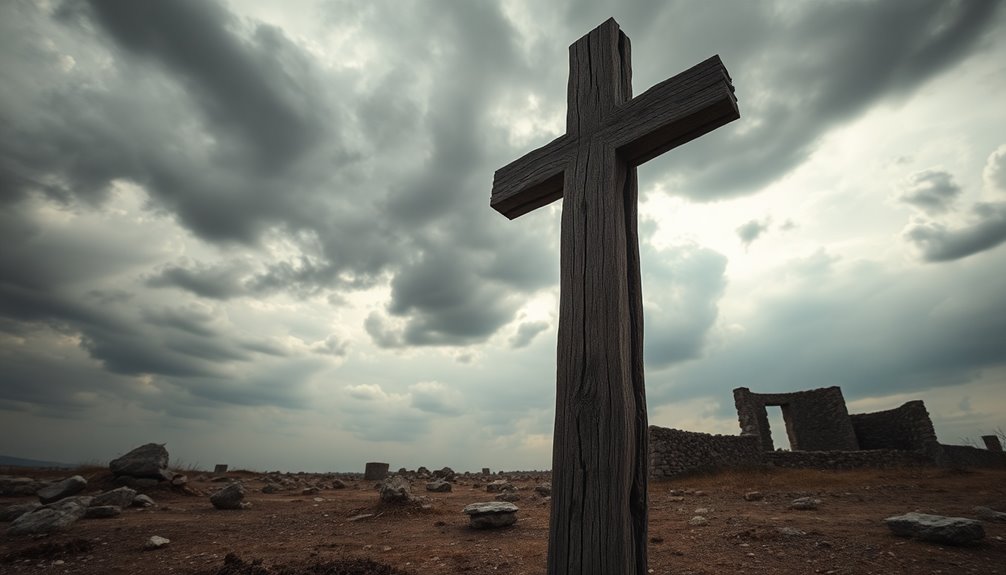The cross represents a powerful transformation from suffering to hope. Initially an instrument of execution, it evolved into a symbol of divine love and redemption in Christianity. You'll find it in churches and personal jewelry, reminding believers of their faith journey. Scriptural references highlight its significance as a cancellation of sin and a testament to God's love through Jesus' sacrifice. While often misunderstood, the cross also showcases life and death's interconnectedness across cultures. If you explore further, you'll uncover deeper insights into its rich historical and theological meanings and how it impacts modern spirituality.
Key Takeaways
- The cross symbolizes the transformation from death and suffering to hope and redemption in Christian theology.
- It represents God's love through Jesus' sacrificial death, as emphasized in John 3:16.
- Historically, the cross was a Roman execution tool, later adopted as a symbol of faith and salvation.
- The cross serves as a reminder of interconnectedness in life and death across various cultures.
- Community service reflects the principles of love and humility embodied by the cross, demonstrating faith in action.
Introduction

The cross, a powerful symbol, has a rich history that transcends its original purpose as a tool for execution. Initially, it represented death and suffering, but with the arrival of Jesus Christ, it transformed into a profound emblem of hope and redemption. You might see the cross displayed atop churches or worn as jewelry, serving as a constant reminder of faith and sparking conversations about spiritual beliefs.
In Christian theology, the cross signifies the ultimate sacrifice of Jesus Christ, embodying the forgiveness of sins and the victory over death through his resurrection. This transformation reflects a journey from despair to hope, illustrating how something once associated with punishment can become a symbol of love and salvation.
Historically, the cross was also tied to various cultures and deities, symbolizing the duality of life and death long before its adoption by Christianity.
Today, you'll find modern interpretations of the cross prompting discussions on faith, morality, and the human experience of suffering and redemption. As you explore what the cross represents, consider its complex history and the messages it conveys in different contexts.
Scriptural Basis for the Cross

When you look at the cross, you can't ignore its deep roots in scripture.
Key verses like John 3:16 and 1 Corinthians 1:18 not only highlight its significance but also show how it transforms lives.
Let's explore these primary and secondary references to understand the cross's powerful message.
Primary Bible References
Throughout the New Testament, several key passages highlight the significance of the cross in the Christian faith. For instance, John 3:16 emphasizes how God's love is demonstrated through the atoning sacrifice of Jesus, who died on the cross for humanity's salvation.
This powerful message resonates in 1 Corinthians 1:18, where Paul explains that the message of the cross was an instrument of both folly to those who are perishing and the power of God to those being saved.
In Galatians 6:14, Paul expresses his pride not in worldly achievements but in the cross of Jesus Christ, showcasing its profound importance for believers.
Similarly, Colossians 2:14 articulates that Jesus' death on the cross canceled the written code that condemned humanity, symbolizing the removal of sin and guilt.
Finally, Hebrews 12:2 encourages you to fix your eyes on Jesus, the author and perfecter of faith, who endured the cross for the joy set before Him.
These references collectively affirm that the cross isn't merely a symbol but the very cornerstone of Christian belief, representing hope, redemption, and divine love.
Secondary Bible References
References to the cross in Scripture extend beyond primary texts, reinforcing its critical role in Christian theology. In 1 Corinthians 1:18, you find that the message of the cross is seen as foolishness to those who are perishing, but to you, it's the power of God. This distinction highlights how the cross shapes belief and understanding.
Paul's words in Galatians 6:14 reveal that he boasts only in the cross of our Lord Jesus Christ, emphasizing its centrality to your faith and identity.
Colossians 2:14 further illustrates this, stating that through the cross, Jesus canceled the record of debt against humanity, symbolizing profound forgiveness and redemption.
Hebrews 12:2 encourages you to fix your eyes on Jesus, the author and perfecter of your faith, who endured the cross for the joy set before Him. This highlights the significance of the cross in your journey of faith.
Finally, 1 Peter 2:24 reminds you that Jesus bore your sins in His body on the tree, underscoring the cross as a powerful symbol of sacrifice and atonement for sin. Each reference deepens your understanding of the cross's impact on your life.
Roman Crucifixion Practices

Crucifixion was a brutal method of execution employed by the Romans, primarily targeting slaves, revolutionaries, and criminals. This horrific practice served as a stark warning, designed to deter others from rebellion or dissent.
Victims were typically nailed or tied to a wooden cross, leading to a slow, agonizing death often caused by asphyxiation or shock from blood loss. When you think about those who were crucified with Christ, it's important to remember the public nature of these executions. The cross would be erected in a visible area, turning the event into a spectacle meant to instill fear.
Before their execution, victims were stripped of clothing, heightening their humiliation. Executioners often divided the garments among themselves, as seen in biblical accounts of Jesus' crucifixion.
The Roman legal system allowed for such brutal actions without a formal trial in certain cases, showcasing the absolute power authorities had over life and death. This context makes the death on the cross not just a personal tragedy for Jesus, but a chilling reminder of the oppressive measures used by the Romans to maintain control over their subjects.
Historical Significance of the Cross

The historical significance of the cross goes beyond its grim origins as a tool of execution; it reflects a profound evolution in meaning over time. Originally, the cross symbolized a brutal method of punishment used in ancient Rome for public executions.
Yet, its history stretches back even further, appearing in various ancient cultures as a symbol of protection and ritual significance long before Christianity.
With the rise of Christianity, the cross underwent a dramatic transformation. No longer just a representation of death and humiliation, it became a powerful emblem of hope and redemption. This pivotal shift marked a new chapter in Christian theology, where the cross signified not only sacrifice but also the promise of eternal life.
Today, you'll find the cross displayed atop churches and woven into religious rituals, emphasizing its spiritual significance in the faith.
It's fascinating to see how the cross has transcended its initial purpose, connecting diverse beliefs and symbolizing the interconnectedness of life and death across cultures. This evolution illustrates how symbols can reshape their meanings, turning a tool of execution into a profound representation of faith and salvation.
Misunderstanding the Cross's Origins

When you think about the cross, it's easy to see it only as a Christian symbol, but that overlooks its complex history.
Many ancient cultures used cross-like symbols to convey deep meanings about life and the divine long before Christianity.
Debunk Common Misconceptions
Throughout history, many people have misunderstood the true origins of the cross, believing it solely represents Christian symbolism.
In reality, the cross was originally a Roman instrument of execution, used for public torture and death long before it became associated with Christianity. Ancient cultures utilized the cross in various forms, often symbolizing life, death, and protection, predating its adoption by Christian theology.
The term "crucifixion" comes from the Latin word "crux," which emphasizes its function as a method of execution rather than its later religious significance.
Early Christians transformed the cross from a symbol of shame and suffering into one of hope and redemption through the resurrection of Jesus. This shift often leads to misconceptions that ignore the cross's broader cultural and historical context.
Cultural Interpretations of the Cross
Exploring the cultural interpretations of the cross reveals a rich tapestry of meanings that extend far beyond its Christian connotations. Before Christianity, the cross served as an ancient symbol in various cultures, often linked to rituals and protection, representing both life and death. You can find early depictions of the cross in Mesolithic cave art, highlighting its importance in human history long before it became a Christian emblem.
In many pre-Christian societies, the cross was tied to different deities and spiritual beliefs, showcasing its diverse cultural interpretations. However, as the cross transitioned to a Christian symbol, its meaning evolved dramatically. It shifted from a representation of execution and suffering to one of sacrifice, redemption, and hope, aligning with God's plan for humanity.
Today, misunderstandings about the cross's origins often arise from its commodification in modern culture. Many people see it merely as a fashion statement, overlooking its profound historical and theological significance.
Faith in Everyday Choices

Every day, you face choices that can either reflect your faith or stray from it.
By engaging in community service and acts of kindness, you embody the principles of love and humility that the cross represents.
Your decisions not only impact your spiritual growth but also serve as a testament to your commitment to living out your beliefs.
Daily Decisions Reflecting Faith
The cross stands as a powerful symbol that can guide your daily decisions, reminding you to align your choices with the teachings of Jesus. Each day, you're faced with opportunities to reflect your faith through your actions. God loves you unconditionally, and your choices can mirror that love by prioritizing compassion and selflessness.
When you think about the sacrifice for our sins, it encourages you to act with humility and grace, just as Jesus did.
Consider how your daily interactions can embody forgiveness and integrity. Small acts of kindness, a patient response to frustration, or a willingness to help others can resonate deeply with the message of the cross. Philippians 2:7-8 reminds you of Jesus' humility and obedience, urging you to adopt a similar mindset in your decisions.
Engaging in prayer and reflecting on the cross's significance can further guide your choices. Take time to connect with your faith, allowing it to shape how you approach challenges. Additionally, embracing unconditional love in your relationships can enhance your ability to reflect Jesus' teachings through your daily actions.
Community Service Initiatives
Serving others is a tangible way to put your faith into action, reflecting the love and compassion symbolized by the cross. Jesus taught us to love and serve others, and community service initiatives provide a practical outlet for this calling. Many churches organize outreach programs like food drives, clothing donations, and community clean-up days, embodying the spirit of service demonstrated through Christ's sacrifice.
By participating in these initiatives, you not only help those in need but also deepen your understanding of how God loves us and calls us to extend that love. Faith-based organizations often team up with local charities to tackle pressing social issues such as homelessness and hunger, showcasing the compassion and care that the cross represents. Engaging in community service enhances your personal faith, encouraging you to live your beliefs actively. It aligns your everyday choices with the self-denial and humility exemplified by the cross.
Many Christian denominations stress the importance of serving others as a true expression of discipleship, reminding you that your actions reflect the sacrificial love of Jesus. In doing so, you become a living testament to the values the cross represents. Additionally, participating in community service can also lead to enhanced mental clarity, allowing you to better connect with the purpose behind your actions.
Cross Symbolizes Sacrifice and Hope

Throughout history, the cross has come to symbolize profound sacrifice and hope in Christianity. It stands as the ultimate representation of Jesus' willingness to endure suffering and death for humanity's redemption. When you reflect on His crucifixion, you see the fulfillment of Old Testament prophecies, particularly in Isaiah 53, where the suffering servant bears the iniquities of many.
This act of sacrifice isn't just about pain; it's the culmination of God's love for you, as stated in Romans 5:8—Christ died for the ungodly. The cross transitioned from a tool of execution to a powerful emblem of hope and salvation. Through Christ's death and resurrection, believers like you gain the promise of eternal life.
For many Christians, the cross serves as a source of personal hope and strength. It symbolizes forgiveness and the possibility of new beginnings through faith.
Whenever you see the cross, remember it embodies a profound message: that sacrifice leads to hope, and through that hope, you can find renewal and purpose in your life.
Additional Resources

Many valuable resources are available to help you explore the significance of the cross in Christianity. The Billy Graham Evangelistic Association offers a wealth of teachings and sermons that delve into the cross's role as a symbol of Jesus' sacrifice and the Resurrection of Jesus. Engaging with these materials can deepen your understanding of how the cross represents redemption for humanity's sins.
In addition, literature and art often depict the cross, showcasing its themes of hope and sacrifice across different cultures. You might find that exploring these artistic interpretations enriches your appreciation of the cross's significance.
Online platforms and religious organizations provide educational resources, discussions, and reflections that examine the theological implications and historical context behind the cross. Participating in these discussions can enhance your spiritual journey and connection to the cross.
Finally, consider engaging in devotional practices such as the Stations of the Cross. These practices allow you to actively reflect on Jesus' Passion, fostering a deeper spiritual connection to the events surrounding the cross and the Resurrection of Jesus.
Frequently Asked Questions
What Does the Cross Symbolize?
When you think about the cross, it symbolizes more than just an object; it embodies profound themes.
You might see it as a representation of sacrifice, love, and hope. It evokes feelings of redemption and a connection to something greater.
The cross can also remind you of the struggles faced and the triumph over adversity.
For many, it's a personal emblem of faith, sparking conversations about beliefs and the journey of life.
What Is the True Message of the Cross?
The true message of the Cross is about love, sacrifice, and redemption. It reminds you that no matter your flaws, you're embraced and valued.
Through Christ's willingness to endure suffering, you're offered forgiveness and a fresh start. The Cross invites you to deepen your relationship with God, encouraging you to reflect on His compassion and grace.
Ultimately, it symbolizes hope and the promise of eternal life for those who believe.
What Is God's Purpose of the Cross?
God's purpose for the cross is to offer you redemption and reconciliation.
Through Jesus' sacrifice, He's made a way for you to be forgiven and restored to a relationship with Him.
It's not just about justice; it's about love, showing how deeply He cares for you.
The cross calls you to live a life of faith, embracing self-denial and following Christ's example, demonstrating your commitment to His will in your life.
What Is the Secret Meaning of the Cross?
The secret meaning of the cross often dives deeper than its surface symbolism. It invites you to reflect on themes of sacrifice, love, and redemption.
When you see the cross, think about the profound connection it represents between humanity and the divine. It challenges you to embrace humility and self-denial, reminding you that true strength lies in love and compassion.
Ultimately, it encourages you to pursue a transformative journey of faith and salvation.










